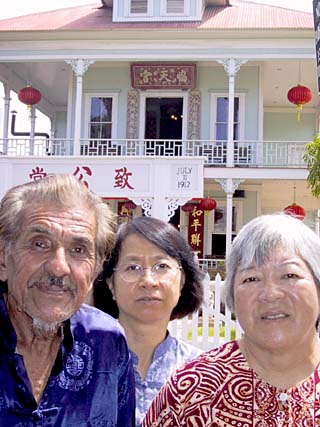
GARY KUBOTA / GKUBOTA@STARBULLETIN.COM
Members of the Wo Hing Temple on Maui will be celebrating the Chinese Moon Festival tomorrow. Pictured are members Joseph Lai, Busaba "Yip" Paratacharya and Carolyn Kam.
Maui moon fest
looks back at
Chinese culture
LAHAINA >> When Carolyn Kam thinks of her childhood in Lahaina town in the 1950s, she remembers thriving Chinese businesses along Front Street. Smells of manapua and stone-baked bread wafted from her family's Hop Wo Store.
"People would line up for the bread," she said. "It was 10 cents a loaf."
Although most of the Chinese store owners of the era have died and their children have moved out of Lahaina, the temple that was the center of their social life serves as a reminder of their contribution to the culture of Hawaii.
The Wo Hing Temple, now a museum, will host a Chinese Moon Festival tomorrow. Admission to the museum is $1.
Museum official Busaba "Yip" Paratacharya said the temple complex, open from 10 a.m. to 8 p.m., will feature a shadow puppet show from 4 to 8 p.m. and displays about historic guns and the moon festival.
Festival organizers will also be selling moon cakes, made of sweet black bean and lotus seeds, coated with a baked flour shell.
The festival, part of the Taoist tradition, takes place toward the end of the harvest season and is held to express a hope for harmony with nature and gratitude to the moon goddess, Paratacharya said.
In the early to mid-1900s, Lahaina was a sugar and pineapple plantation town, and there were several Chinese family-run stores, Kam recalled.
According to the Lahaina Restoration Foundation, Chinese merchants began migrating to Hawaii just 10 years after British explorer Capt. James Cook arrived in 1778.
Besides working at agricultural jobs, the Chinese helped build tunnels and an irrigation system throughout the West Maui Mountain.
Although an altar room was built on the second floor of the temple for prayers and funerals, the building was used mainly as a social meeting hall until the 1940s, then as a residence for elderly Chinese men.
Joseph Lai, whose father once operated Lai Tong Store on Front Street, said the Wo Hing Temple was a kind of club where men gathered to socialize and discuss world events, including news from China.
The members were among the free thinkers of their time, a branch of the Kee Kung Tong, popularly known as the Freemasons of China.
Kam said women and children would come to the temple to celebrate special occasions, such as Chinese New Year.
By the 1960s most of the Chinese stores were shutting down as the immigrant store owners died. Kam said her father's store was the last Chinese store to close on Front Street in the mid-1970s.
Lahaina was transforming itself into a town catering to visitors.
Under an agreement with the Wo Hing Society, the Lahaina Restoration Society began restoring the temple in 1983 and has continued to operate it as a museum.
Kam said she is looking forward to the moon festival celebration and sharing the history of the Wo Hing Temple and Chinese in Lahaina with visitors.
"They're curious about what we did before tourism," she said. "I find it kind of interesting talking to them."
